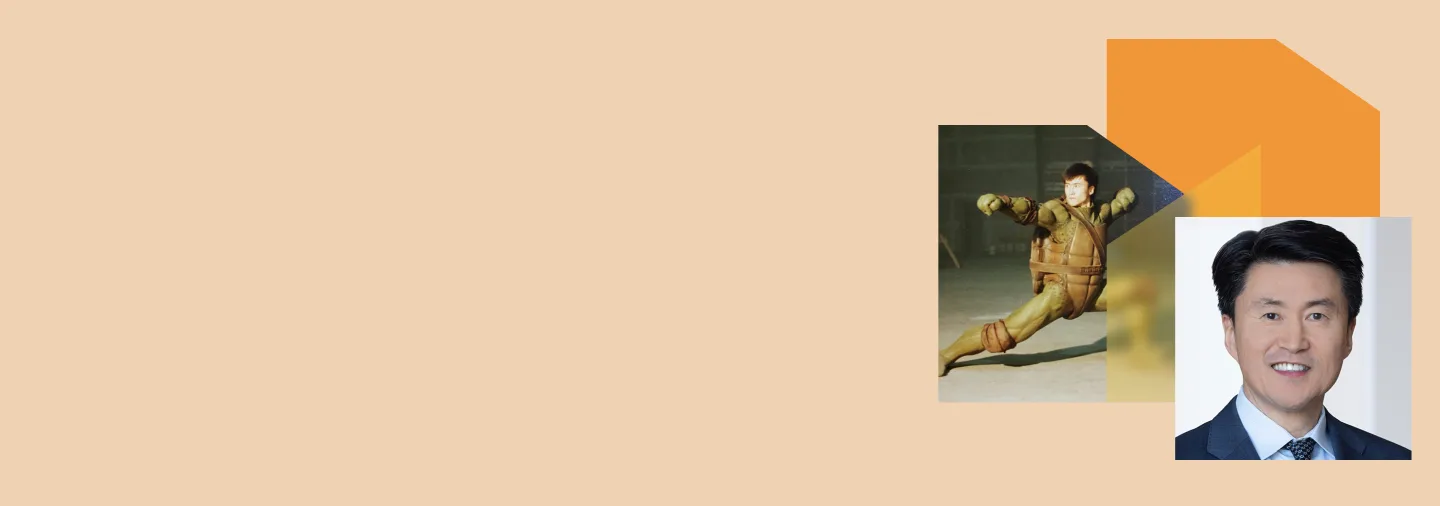Hoyoung Pak was 6 when he, his younger brother, older sister, and parents moved from South Korea to the U.S., suitcases in hand, and just $5,000 among them.
He and his little brother Ho-Sung loved to play video games and baseball, and weren’t particularly interested in their father’s suggestion to take up taekwondo until they caught a fateful Bruce Lee double-feature as teenagers. “Once, I saw that, I was like, I want to do martial arts like Bruce Lee!” says Hoyoung Pak, Global Co-Leader of AlixPartners’ AI & Data Practice.
He took up wushu (the Chinese martial art), and it changed the course of his life. “Martial arts gave me the ability to hyperfocus and persevere through challenges,” he says. “I went from being a really bad student in sophomore year to becoming a straight-A student in junior year.”
His marks got him into a “good” engineering program, which allowed him to transfer into one of the top programs in the country at University of Illinois, Urbana-Champaign. He knew he would do a doctorate–in record time, as it turned out–and moved to Albuquerque, N.M., to complete his post-doctoral research in engineering.

Laser focus in action
Out in the desert landscape of Albuquerque, Hoyoung did his thesis on Monte Carlo simulations to optimize semiconductor etching reactors and thyratrons used to switch high-powered lasers—providing far more cost-effective solutions than repeatedly building physical prototypes.
For example, he built a model comprising thousands of lines of code to study exactly how electrons and ions interact, and how the electric and magnetic fields behave. “It's a painstaking effort to build these models,” explains Hoyoung. “But once it's built, you can run thousands of simulations to change the diameter, separation, or other dimensions, and determine the optimal configuration.” Exciting work.
But that was just his day job.
In the evenings, Hoyoung had a lot of spare time to fill. “I thought, why not teach martial arts? I wanted to give back so others could experience the same benefits I gained from martial arts training,” he says. He started with just six students at a local health club, and soon his efforts grew into a 5,000-square-foot martial arts school—the largest in New Mexico.
He also joined the NASKA (North American Sport Karate Association) tournament circuit, catching Hollywood’s attention.

Turtle power
Hoyoung was competing in a NASKA tournament in Atlanta when he was scouted by Pat Johnson, the fight choreographer for the Batman movies, Karate Kid, and Teenage Mutant Ninja Turtles (1990). Johnson asked Hoyoung and Ho-Sung if they wanted to be involved in the TMNT sequel, Teenage Mutant Ninja Turtles II: The Secret of the Ooze (you may recall the Vanilla Ice rap from the film).
“If Pat had asked us to do the original TMNT movie, we’d have thought it was crazy—people in turtle costumes?” recalls Hoyoung. “But by then, Turtles part one was a huge hit with a billion dollars of paraphernalia sales.”
He wanted to do the movie but, being in the middle of his dissertation, needed approval from his thesis advisor. “I asked, ‘Do you mind if I take off a month to do something called the Ninja Turtles?’”
Thankfully, his advisor said the Monte Carlo simulations could wait. Filming took place in Wilmington, NC, where Hoyoung performed fight scenes for Donatello.
“Interestingly, Donatello is a scientist, like I was,” says Hoyoung. His brother Ho-Sung performed stunts for Raphael, the rebel of the group.

None of it was CGI.
Hoyoung remembers that Tokka, the villain in the movie, was “truly scary looking in real life,” and vividly describes a scene where the mutant snapping turtle tossed Donatello’s stunt double through the air and into a shed. “On set, the mechanics were incredible," says Hoyoung. "With just the push of a button, the stuntman was launched by a pneumatic pulley system. My jaw just dropped. I thought, did I just see a human being shot through the air 50 yards?”
As thrilling as it was to embody turtle power, Hoyoung recalls that production was often a lot of “hurry up and wait,” sitting around in his half shell while technicians adjusted the lighting.
He and Ho-Sung went on to perform as martial artists in the TV series WMAC Masters—you can still buy a Hoyoung Pak action figure from that era on eBay. For the brothers, this was where their paths diverged.

Rise of the machines
Ho-Sung was bitten by the acting bug and went on to work with Jackie Chan and Madonna, as well as in films like Transformers and Bullet Train.
Spurred by his experience developing his martial arts business, Hoyoung decided to pursue an MBA following his PhD. He graduated from the Kellogg School of Management at Northwestern University and then joined McKinsey. He went on to become an executive at companies like Discover, Groupon, and Ace Hardware. Later, he led artificial intelligence (AI) as General Manager of Uptake and Chief Operating Officer of SGS before joining AlixPartners in 2022
At the firm, he guides clients in finding practical use cases for AI and driving change within their organizations as the AI revolution proceeds. Hoyoung helps business leaders "understand exactly what AI can do."

Amid the hype, he explains the potential for AI with an analogy from martial arts. In a fight, you can get knocked out by a punch or kick if you're focused on the hand or foot, because they move too fast to react to. But through repetition, you start to learn. "What you start to see is patterns like the movement of shoulders or hips that help you rapidly predict if it's going to be a roundhouse kick or reverse punch, so you know how to counterattack," he explains.
Companies similarly aim to build early detection systems, using AI to track and respond to patterns and signals in key business metrics, whether it's customer churn, supply chain dynamics, or seasonal demand. “The key to success is identifying a portfolio of high-impact use cases that are aligned with the overall strategy and have buy-in from key stakeholders. Once that's established, everything else flows from there—including data, technology, and the team required to build and deploy AI models,” he says.
“People often get enamored with chatbots, but it's important to consider the scale. For example, if a $3 billion company has only 50 customer service representatives, implementing a chatbot may not create meaningful value for the firm,” he says.
Instead, practical applications of AI require leaders to ask: "What are the big problems we need to solve?"
Whether the problem is a mutant villain or a disrupted industry, he knows how to think through the challenge and string together a series of moves to achieve success.
